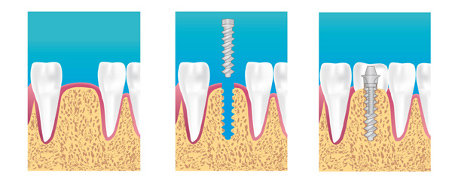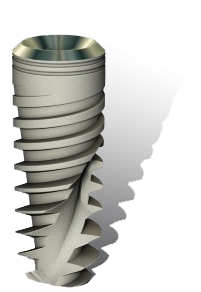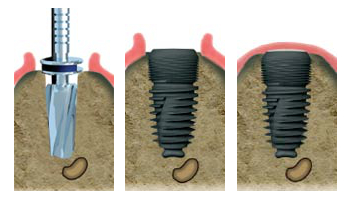
A dental implant is an artificial tooth root used in dentistry to support restorations that resemble a tooth or group of teeth. Virtually all dental implants placed today are root-form endosseous implants. In other words, virtually all dental implants placed in the 21st century appear similar to an actual tooth root (and thus possess a "root-form") and are placed within the bone (end- being the Greek prefix for "in" and osseous referring to "bone").

Prior to the advent of root-form endosseous implants, most implants were either blade endosseous implants, in that the shape of the metal piece placed within the bone resembled a flat blade, or subperiosteal implants, in which a framework was constructed to lie upon and was attached with screws to the exposed bone of the jaws. Dental implants can be used to support a number of dental prostheses, including crowns, implant-supported bridges or dentures.
Surgical planning
Prior to commencement of surgery, careful and detailed planning is required to identify vital structures such as the inferior alveolar nerve or the sinus, as well as the shape and dimensions of the bone to properly orient the implants for the most predictable outcome. Two-dimensional radiographs, such as orthopantomographs or periapicals are often taken prior to the surgery. In most instances, a CT scan will also be obtained. Specialized 3D CAD/CAM computer programs may be used to plan the case. Whether CT-guided or manual, a 'stent' may sometimes be required to facilitate the placement of implants. A surgical stent is an acrylic wafer that fits over either the teeth, the bone surface or the mucosa (when all the teeth are missing) with pre-drilled holes to show the position and angle of the implants to be placed. The surgical stent may be produced using stereolithography following computerized planning of a case from the CT scan.
Basic procedure
In its most basic form the placement of an osseointegrated implant requires a preparation into the bone using either hand osteotomes or precision drills with highly regulated speed to prevent burning or pressure necrosis of the bone. After a variable amount of time to allow the bone to grow on to the surface of the implant (osseointegration) a tooth or teeth can be placed on the implant. The amount of time required to place an implant will vary depending on the experience of the practitioner, the quality and quantity of the bone and the difficulty of the individual situation.

Dental implants represent an great solution for numerous dental problems.
For contraindications, or more information, ask your dentist